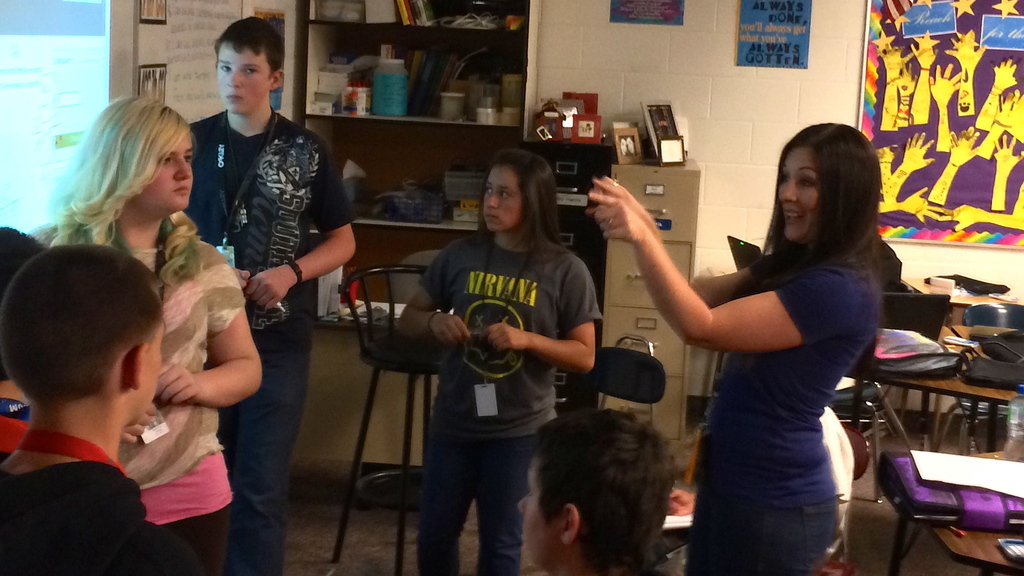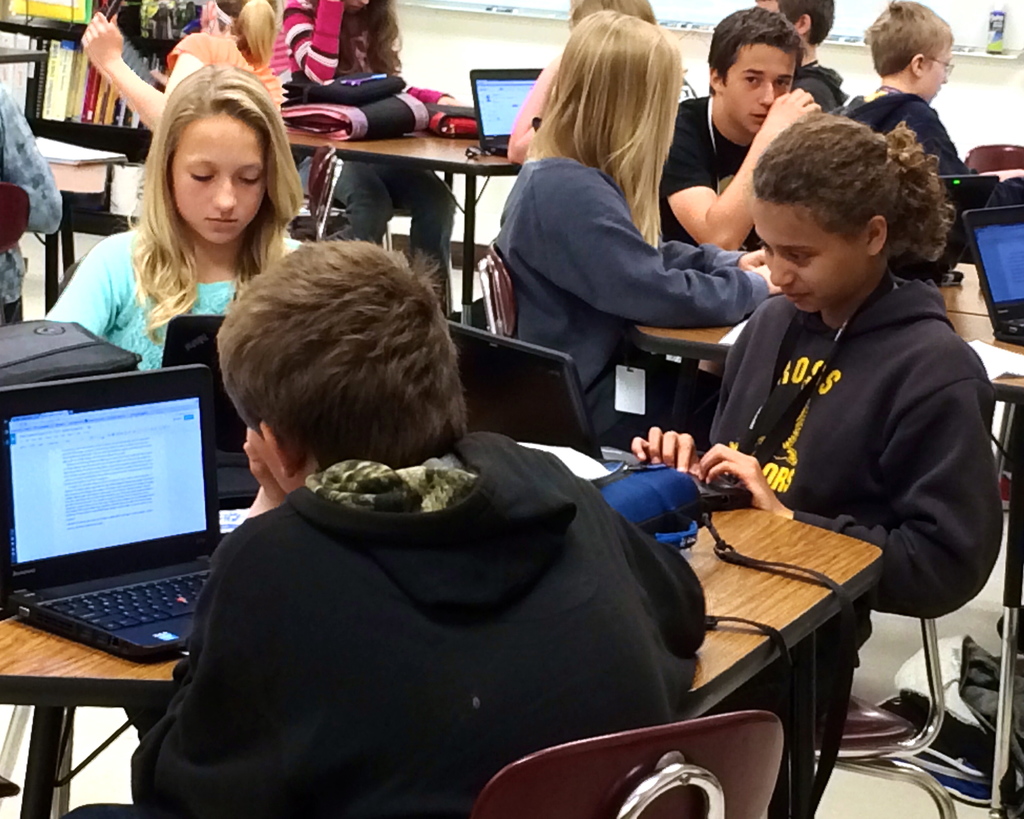
EDITOR’S NOTE: Across Idaho, 11 schools are wrapping up the first year of their technology pilot programs. How are the pilots doing, and how have the schools spent their share of $3 million in state grants? For answers, Idaho Education News and Idaho On Your Side, KIVI and KNIN TV, visited three pilot schools, including Kuna Middle School.
Shelby Harris’ seventh-grade math class is moving in several directions. One group of students works on problems at a whiteboard. Other students are working together on desktop computers. Others are taking or retaking tests.
A few doors down, a seventh-grade science class is working on five-paragraph essays on the human anatomy. This classroom is as quiet as Harris’ classroom is active. The mood is serious, the students on task.
The unifying characteristic: the individualized Chromebooks used by the nearly 800 students at Kuna Middle School. The stripped-down computers are changing the learning process, across the curriculum — and Principal Deb McGrath says she is seeing the difference in math and writing performance. The pilot program is enough of a success that the school wants money to provide similar devices to every high school student.
‘Little teachers’
Harris has been using Chromebooks in her class for more than a year — even before Kuna Middle School received its $891,200.20 state technology pilot grant. She used a J.A. and Kathryn Albertson Foundation grant to begin using the devices, and online curriculum through the Khan Academy.
A year into the transformation, she says the technology changes the way students learn math, allowing them to learn at their own individual pace.
But that doesn’t mean they are learning in isolation. Social barriers are breaking down, as small group work becomes the norm. Students aren’t just learning math skills: they are picking up a new set of communication skills. They are learning to seek out help from classmates — and not always from their closest friends. They are learning how to give help, without giving too much help.
And that, in turn, helps Harris. Sometimes, as she tries to explain a concept to a student, she looks for an assist from another student — someone who can “speak seventh grade.”
Said Harris: “They’re becoming little teachers. It’s amazing.”
A writing instrument

Before Kuna Middle School received its grant and its Chromebooks, one of the school’s most crowded rooms was an overtaxed computer lab. One teacher joked about being in “farming,” said district educational technology specialist Ashleigh Jensen — forever farming out students, a few at a time, to computer lab.
The one-to-one devices allow teachers to do things that were once difficult, if not impossible.
Even a five-paragraph essay on anatomy would have posed a logistical challenge a year ago. Students would have had to write their essays longhand, or wait their turn on one of a handful of desktops lined up against one wall.
The Chromebooks aren’t just a writing device. They allow students to conduct Internet research as they go. By using Hapara — a Chromebooks app that allows teachers to track students’ work — one language arts teacher has learned how to provide help on the fly. If students are struggling with citations or a thesis statement, they can be pulled aside for a quick tutorial.
A year into the Chromebooks pilot, the school is already seeing some improvements on short-term math and writing assessments. And with writing looming as a key component in the new Idaho Core Standards, Kuna students are writing much more, and not just in language arts class.
“And it’s good writing,” McGrath said. “It’s critical thinking, down on paper.”
Surviving the SBAC
In late April, the Chromebooks passed one key test.
Kuna’s students were able to get through the Smarter Balanced Assessment Consortium assessment quickly.
The SBAC — a new computer-based test aligned with the Idaho Core Standards — takes several hours for students to complete. Jensen says she has heard about other schools, smaller than Kuna, which have had to stretch the exam over five weeks.
That was Kuna, in years past. It used to take five weeks of computer lab time to get students through the SBAC’s predecessor, the Idaho Standards Achievement Test.
This year, students were working on a familiar device, doing some of their own troubleshooting along the way. And students completed the test in four days.
“The fact that we were able to protect instruction time was phenomenal,” McGrath said.
Thinking beyond middle school
When eighth-graders head for Kuna High School, they will take a step back in time. They will enroll in a school with about 2,000 students and maybe 100 Chromebooks to go around.
Not surprisingly, those Chromebooks are in constant demand.
The prospect of going from new school to old school has been a concern for Kuna officials since July 1 — the day officials got the news about the middle school Chromebooks grant.
“It was an immediate thought, and we’ve been working all year to try to figure something out,” Jensen said.
Kuna is hoping the $3 million state pilot program will come through again. Jensen is working on another grant application, hoping for money for a high school Chromebooks program. At $891,000, Kuna received the biggest chunk of grant money for 2014, but Jensen doesn’t think a high school grant program would cost much more than the middle school program. Kuna would need more Chromebooks for the high school, but the school already has a lot of the infrastructure it needs. Applications are due June 11.
Regardless of the outcome of the grant application, Kuna High School will get a new group of ninth-graders with a new set of skills. The year with the Chromebooks has sharpened the students’ technical and argumentative writing skills, and honed their research skills.
Recently Kuna’s middle school science teachers met with their high school counterparts, telling them what to expect this fall. What did the high school teachers think?
“They were pleasantly surprised,” said McGrath.
More reading: Here is our September story from Kuna Middle School. And a link to Kuna’s grant application. Get more data about Kuna Middle School — a three-star school, under Idaho’s latest five-star ratings — at Idaho Ed Trends.
Disclosure: Idaho Education News is funded through a grant from the J.A. and Kathryn Albertson Foundation.
